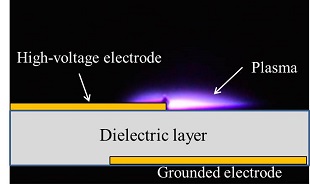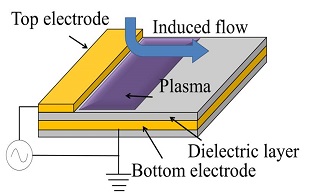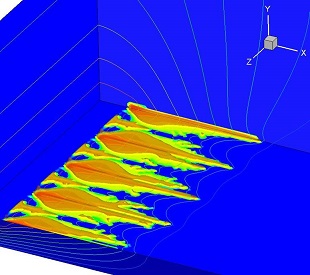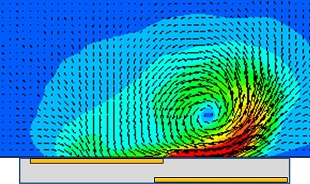プラズマを用いた先進的流体制御技術の研究開発

メンバー: 西田浩之
分野: 総合工学
所属: 大学院工学研究院 先端機械システム部門
キーワード: 先進流体制御技術、誘電体バリア放電、プラズマ
ウェブサイト:
研究概要

誘電体バリア放電を物体周りの流れ制御に利用するデバイス、DBDプラズマアクチュエータは、機械的可動部が必要無い、非常に薄く軽量、制御入力に対して応答が速いなど特筆すべきメリットを備えていることから、近年流体工学に関わる幅広い分野において注目を集めている。しかしながら、制御力の不足や詳細な作動特性が不明であること、湿気などの悪環境中における駆動の信頼性など、実用化のために解決すべき課題が残されている。本研究では、これらの課題の解決に取り組み、DBDプラズマアクチュエータの実用化を目指す。
DBDプラズマアクチュエータは絶縁体を2枚の電極で挟んだ構造をしたデバイスであり(Fig.1を参照)、電極と絶縁体はそれぞれ金属テープと絶縁シートなどの薄く軽量な材料で作ることができる。2枚の電極間に数kV数kHzの交流電圧を印加することで放電を起こし、デバイス表面に沿った方向に空気の流れを誘起できるデバイスである。この空気の流れを物体周りの流れのコントロールに利用する。空気の流れが誘起されるメカニズムは、放電により発生したプラズマと周囲の空気との相互作用によるものであると考えられている。本研究室では、この作動メカニズムをクリアにするため、放電プラズマの数値シミュレーション(Fig.2)と実際にアクチュエータを作成しての実験(Fig.3)を行っている。アクチュエータの制御力を上げるためにはどのような電極形状・印加電圧波形が良いか、周囲の空気圧力や湿度などの環境の変化がアクチュエータの作動にどのような影響を与えるか、などについて明らかにし、プラズマアクチュエータを実用段階の技術にまで発展させることを目標にしている。
主要論文・参考事項
1) H. Nishida, T. Nonomura and T. Abe, “Three-dimensional simulations of discharge plasma evolution on a dielectric barrier discharge plasma actuator,” Journal of Applied Physics 115 (2014), pp.133301-1 – 133301-12.
2) H. Nishida, T. Nonomura and T. Abe, “Characterization of Electrohydrodynamic Force on Dielectric-Barrier-Discharge Plasma Actuator Using Fluid Simulation,” World Academy of Science, Engineering and Technology 6, No.11 (2012), pp.254-258.
3) H. Nishida, I. Funaki, “Analysis of Thrust Characteristics of a Magnetic Sail in a Magnetized Solar Wind,” Journal of Propulsion and Power 28 (2012), pp.636-641.
4) H. Nishida, T. Abe, “Numerical Analysis of Plasma Evolution on Dielectric Barrier Discharge Plasma Actuator,” Journal of Applied Physics 110 (2011), pp.013302-1 – 013302-9.
5) H. Nishida, I. Funaki, Y. Inatani, K. Kusano, “Discussion on Momentum Transfer Difficulty of a Magnetoplasma Sail,” Journal of Propulsion and Power 27 (2011), pp.1149-1153.
6) H. Nishida, T. Abe, “Magnetohydrodynamic analysis of the interaction of magnetized plasma flow with a perfect-conducting object,” Physics of Plasmas 17 (2010), pp.052901-1 - 052901-9.
お問い合わせ先
東京農工大学・先端産学連携研究推進センター
urac[at]ml.tuat.ac.jp([at]を@に変換してください)
Research Development of Plasma Assisted Advanced Flow Control Technique

Research members: Dr. Hiroyuki Nishida
Research fields: Integrated engineering
Departments: Institute of Engineering, Division of Advanced Mechanical Systems Engineering
Keywords: Advanved flow control technique, Dielectric barrier discharge, plasma
Web site:
Summary

Dielectric-Barrier-Discharge (DBD) Plasma Actuator is an advanced flow control device. It utilizes the dielectric barrier discharge for flow control, and recently, gets much attention world wide because it has many advantages such as no mechanical moving parts. Due to its many advantages, the DBD plasma actuator is expected to be applied to various engineering fields.
The conventional DBD plasma actuator consists of two electrodes separated by a dielectric as shown in Fig. 1; the structure is very thin. An alternating high voltage (typically, several kV and several kHz) is applied between the two electrodes, and it generates a dielectric barrier discharge over the dielectric surface. The discharge intorduces a wall-surface jet and the jet can be utilized for the flow control.
The mechanism of the flow induction is considered to be due to the electrohydordynamic interaction between the plasma and the air. In our laboratory, to clarify the working mechanism of the DBD plasma actuator,numerical simulations of the plasma (Fig. 2) and experiments(Fig. 3) are conducted. Our objectives is to optimize the operation parameters and configurations of the DBD plasma actuator for improving the performance of the DBD plasma actuator.
Reference articles and patents
1) H. Nishida, T. Nonomura and T. Abe, “Three-dimensional simulations of discharge plasma evolution on a dielectric barrier discharge plasma actuator,” Journal of Applied Physics 115 (2014), pp.133301-1 – 133301-12.
2) H. Nishida, T. Nonomura and T. Abe, “Characterization of Electrohydrodynamic Force on Dielectric-Barrier-Discharge Plasma Actuator Using Fluid Simulation,” World Academy of Science, Engineering and Technology 6, No.11 (2012), pp.254-258.
3) H. Nishida, I. Funaki, “Analysis of Thrust Characteristics of a Magnetic Sail in a Magnetized Solar Wind,” Journal of Propulsion and Power 28 (2012), pp.636-641.
4) H. Nishida, T. Abe, “Numerical Analysis of Plasma Evolution on Dielectric Barrier Discharge Plasma Actuator,” Journal of Applied Physics 110 (2011), pp.013302-1 – 013302-9.
5) H. Nishida, I. Funaki, Y. Inatani, K. Kusano, “Discussion on Momentum Transfer Difficulty of a Magnetoplasma Sail,” Journal of Propulsion and Power 27 (2011), pp.1149-1153.
6) H. Nishida, T. Abe, “Magnetohydrodynamic analysis of the interaction of magnetized plasma flow with a perfect-conducting object,” Physics of Plasmas 17 (2010), pp.052901-1 - 052901-9.
Contact
University Research Administration Center(URAC),
Tokyo University of Agriculture andTechnology
urac[at]ml.tuat.ac.jp
(Please replace [at] with @.)



